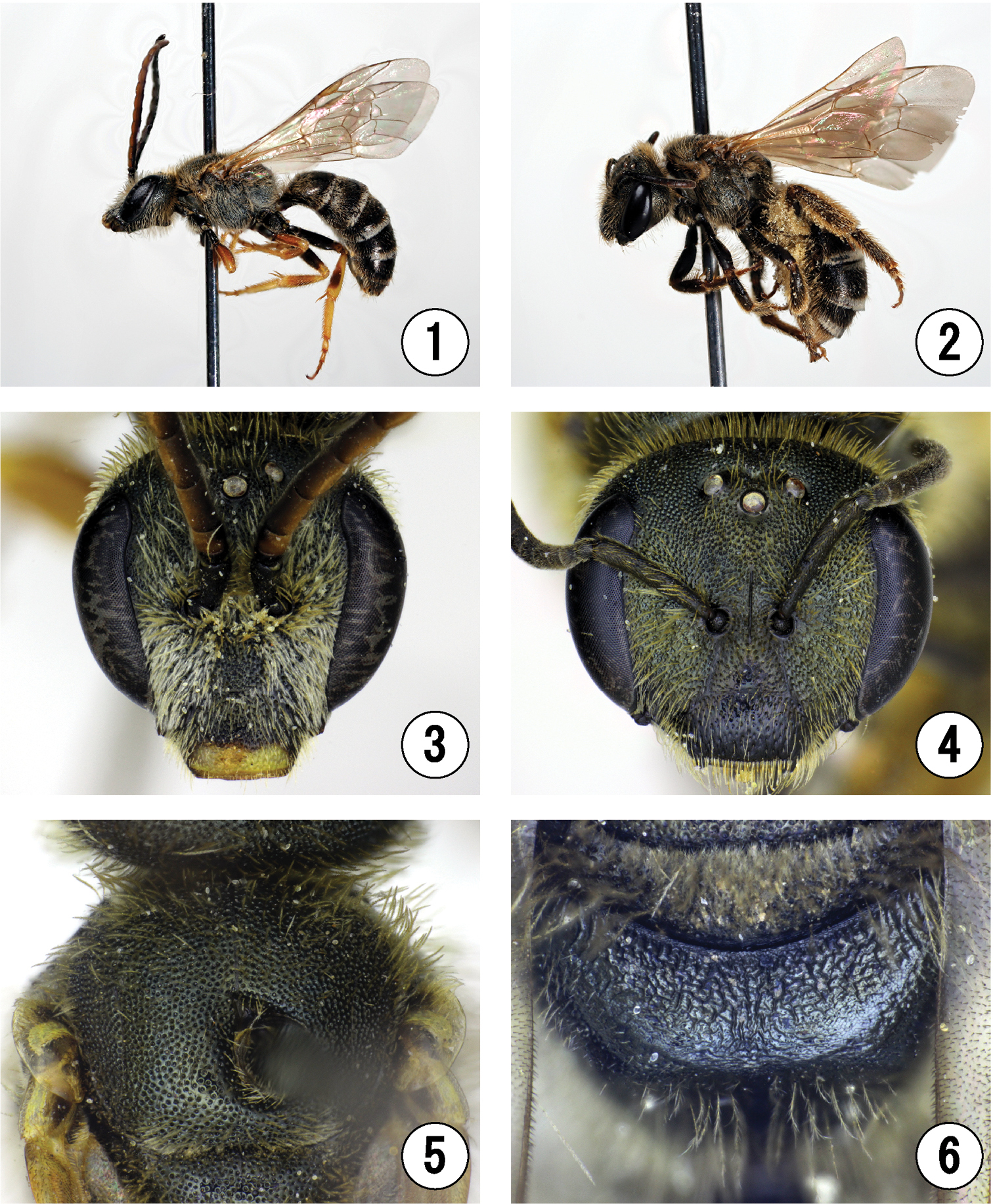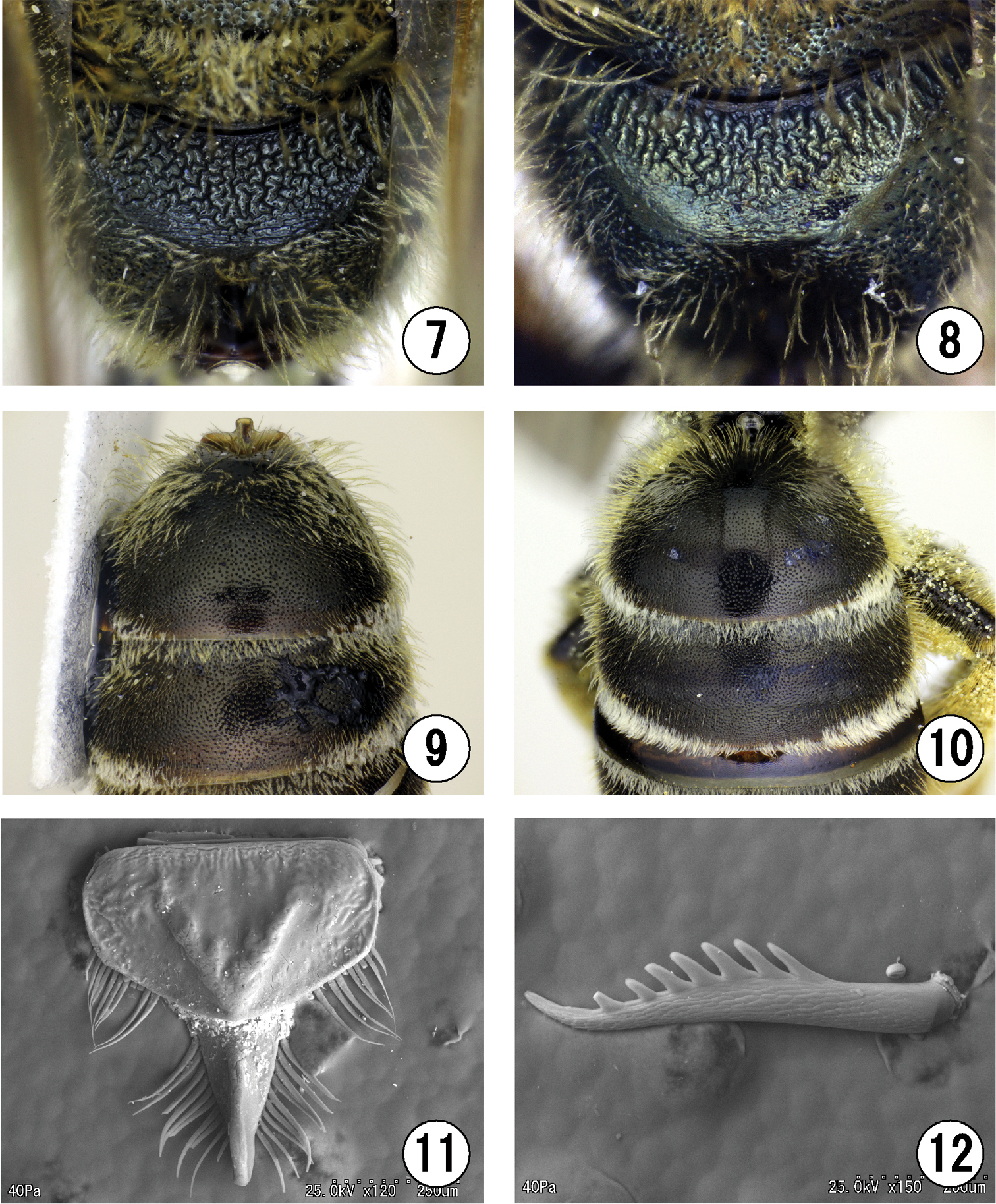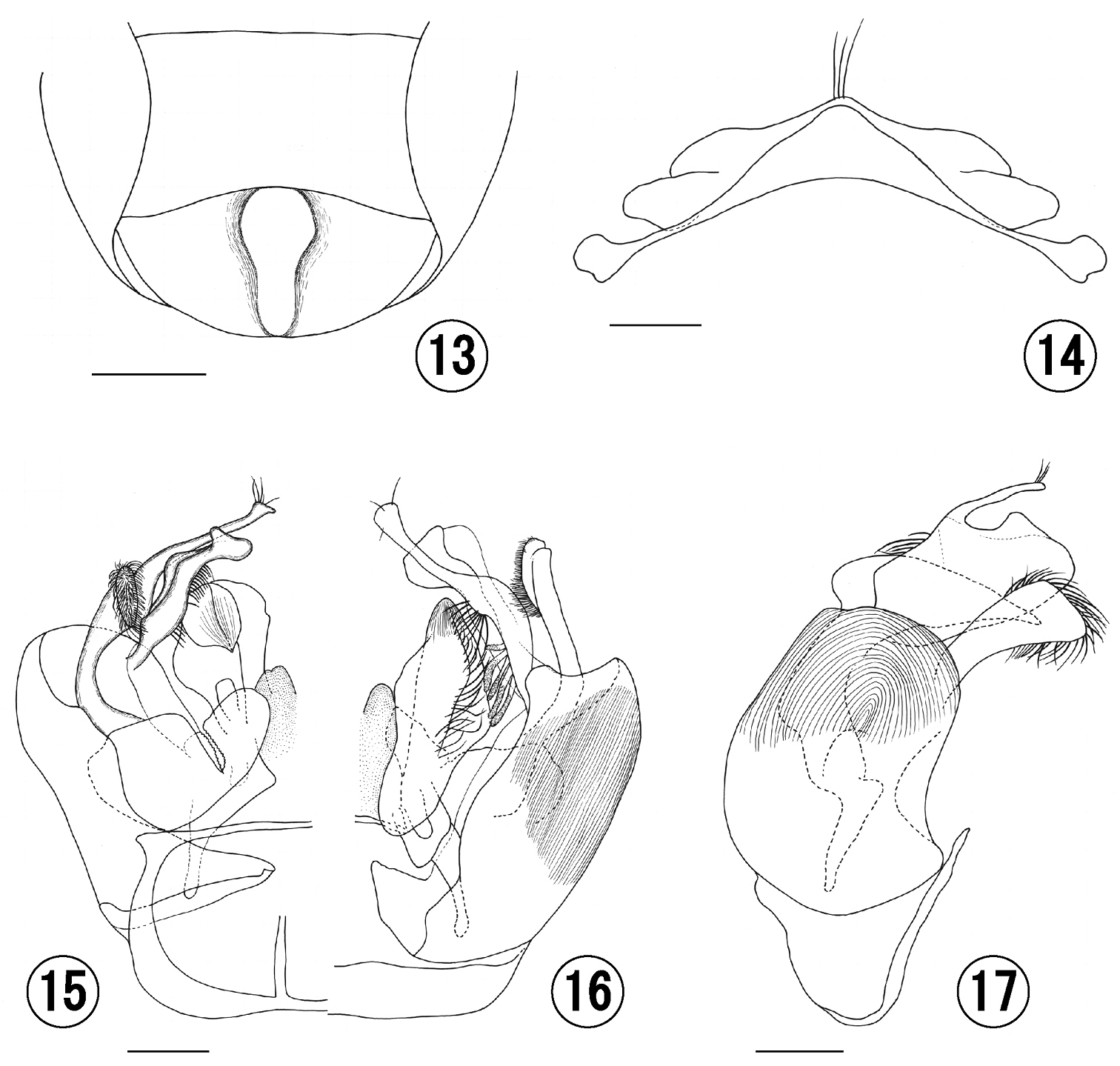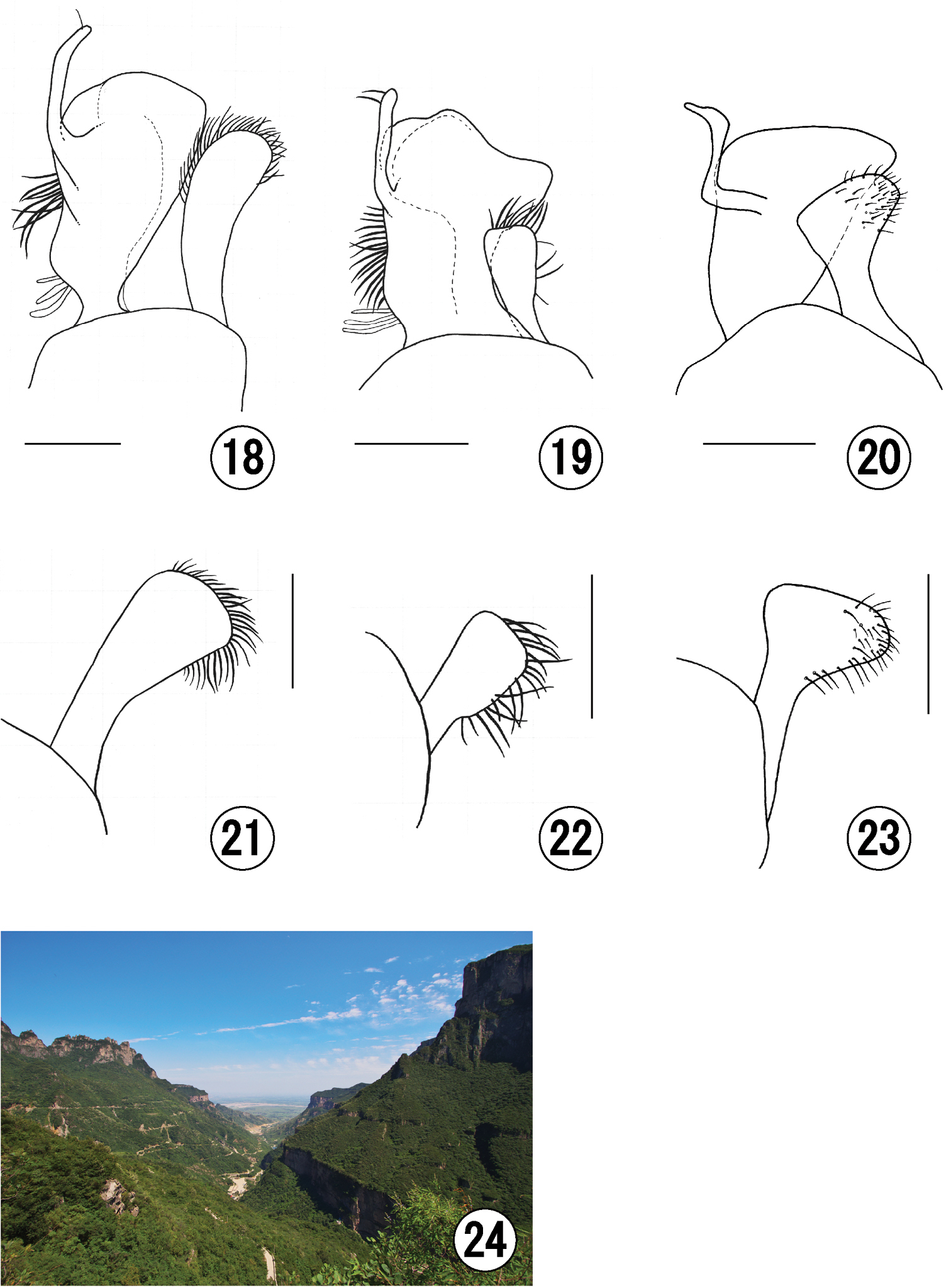






(C) 2013 Ryuki Murao. This is an open access article distributed under the terms of the Creative Commons Attribution License 3.0 (CC-BY), which permits unrestricted use, distribution, and reproduction in any medium, provided the original author and source are credited.
For reference, use of the paginated PDF or printed version of this article is recommended.
Seladonia (Pachyceble) henanensis sp. n., is described from Henan Province, the eastern-central part of China. This species is separated from its allied species by a combination of the following morphological characters: head broad in female, inner hind tibial spur of female with 7–8 slender teeth, T1 basolaterally with appressed hair tuft in both sexes, and genitalia with long and large lower gonostylus in male. Important taxonomic characters are illustrated with photographs, scanning electron micrographs, and line drawings.
Apoidea, Henan Province, taxonomy, new species, Seladonia
The halictine bee genus Seladonia Robertson (Halictidae, Halictinae) is a nearly cosmopolitan group, with 107 recognized species (
Second and third authors, Tadauchi and Xu, visited Henan Province in the eastern-central part of China in 2011 for a collaborative project, and then they collected various wild bees in the area. First author, Murao had an opportunity to examine the specimens, one of which is a new Seladonia species belonging to the subgenus Pachyceble. In the present paper, we describe this new species and illustrate diagnostically important characters with drawings, photographs, and scanning electron micrographs.
This study is based on the specimens deposited in the Entomological Laboratory, Faculty of Agriculture, Kyushu University, Fukuoka, Japan (ELKU), the late Dr. Shoichi F. Sakagami’s collection, deposited in the Museum of Nature and Human Activities, Sanda, Hyogo, Japan (MNHAH), and the first author’s private collection (without abbreviation). Terminology used in the description follows
BL = body length; WL = wing length; HL = head length; HW = head width; IOD = interocellar distance; OOD = ocellocular distance; OCD = ocelloccipital distance; UOD = upper interorbital distance; MOD = maximum interorbital distance; LOD = lower interorbital distance; CAL = clypealveolar distance; CPL = clypeal length; EL = eye length; EW = eye width; GW = genal width; Fn = nth antennal flagellomere; FnL = nth flagellomere length; FnW = nth flagellomere width; MsW = mesosomal width; SCL = mesoscutellar length; MNL = metanotal length; PDL = propodeal dorsum length; MtW = metasomal width; IS = interspace between punctures (IS 0.5 = means 1/2 of the diameter of punctures); PP= punctures. Body measurements are given in ranges followed by the average and standard deviation.
Comparative material examined. Seladonia (Pachyceble) tumulorum tumulorum (Linnaeus, 1758). [SWITZERLAND] 2♀, Schweitz 450m Delémont Fangzeit, 23. vii. 1972 (E. Hüttinger, MNHAH). [AUSTRIA] 2♀, Umgeb. Linz, O. Öst., 31. vii. 1928 (H. Priesner, MNHAH); 1♀, Tirol, Innsbruck Weiherburg, 25. v. 1965 (A.W. Ebmer, MNHAH); 2♀, Oberöst., Linz-Koglerau, 8. vi. 1965 (A.W. Ebmer, MNHAH); 2♀1♂, Biologiezentrum, Linz, 48°20'13.86"N, 14°18'44.78"E, 8. vii. 2012 (R. Murao, 1♂ illustrated in Figs 19, 22); 1♀, Nickelsdorf-Kleylehof, Bulgenland, 12. vi. 1973 (A.W. Ebmer, MNHAH). [JUGOSLAVIA] 1♀, Istrien Ucka 1000m, 13. vii. 1971 (A.W. Ebmer, MNHAH).
Seladonia (Pachyceble) tumulorum ferripennis (Cockerell, 1929): [JAPAN] 7♀, Jozankei N. Sapporo, Hokkaido, 22. v. 1960 (M. Shiokawa, MNHAH), 19. vii. 1960 (M. Shiokawa, MNHAH), 3. vii. 1960 (M. Shiokawa, MNHAH), 31. vii. 1960 (M. Shiokawa, MNHAH); 3♀, University Campus, Sapporo, Hokkaido, 23. v. 1959 (S.F. Sakagami, MNHAH, paratype), 11. vi. 1959 (S. F. Sakagami, MNHAH), 20. viii. 1959 (S. F. Sakagami, MNHAH), 9. ix. 1959 (S.F. Sakagami, MNHAH).
Seladonia (Pachyceble) leucahenea leucahenea (Ebmer, 1972): [KAZAKHSTAN] 2♀, Aksu Valley, alt. 130–560m, S. Kazakhstan Prov., 16. vi. 2003 (O. Tadauchi, ELKU); 1♀, Karaalma, alt. 1210m, near Jabagly, S. Kazakhstan Prov., 17. vi. 2003 (O. Tadauchi, ELKU); 1♀, Achisai, alt. 670–700m, Mts. Karatau, S. Kazakhstan Prov., 4. vi. 2003 (O. Tadauchi, ELKU); 1♀, near Sternjak, Kokchetav District, N. Kazakhstan Prov., 19. vi. 2002 (V. Kazenas, A. Jdanko, and V. Rascheev, ELKU).
Seladonia (Pachyceble) confusa confusa (Smith, 1853): [U.S.A] 1♀, Lapeer Co., MICH., Deerfield twp., 30. v. 1937 (G. Steyskal, MNHAH); 1♂, IND. Hendricks Co. Pittsboro, 9. viii. 1964 (E. R. Jaycox, MNHAH, illustrated in Figs 20, 23).
Seladonia (Pachyceble) confusa arapahonum (Cockerell, 1906): [U.S.A] 2♀, Newton, Ut., 16. iv. 1948 (G. E. Bohart, MNHAH).
Seladonia (Pachyceble) confusa alpina (Alfken, 1907): [AUSTRIA] 1♀, Tirol, 4. v. 1965 (A. W. Ebmer, on Salix sp., MNHAH).
Seladonia (Pachyceble) confusa perkinsi (Blüthgen, 1926): [AUSTRIA] 5♀, Mt. Georgen/G, 9. iv. 1971 (A. W. Ebmer, MNHAH).
Seladonia (Pachyceble) confusa pelagia (Ebmer, 1996): [MONGOLIA] 5♀, Central aimak Songino, 24km SW von Ulan-Baator, alt. 1300m, 7. vi. 1966 (Z. Kaszab, ELKU).
This subgenus is similar to the subgenus Seladonia s. str. in having the following characters: basitibial plate of female usually well developed; propodeal dorsum about as long as metanotum; propodeum usually not densely hairly from lateral to dorsal surfaces; metasomal terga usually with apical and basal bands of pale plumose hairs. But it is separated from them by male antenna long reaching metasoma, male F2 1.7–2.0 times as long as wide, and male S6 with deep depression behind gradulus.
urn:lsid:zoobank.org:act:11562BA6-82CD-4547-932D-DD01DF764DEB
http://species-id.net/wiki/Seladonia_henanensis
Figs 1–18, 21Holotype: ♂, CHINA, Henan Prov., Xinxiang, Mt. Guanshan, Dongling Village, 35°33'34.709"N, 113°31'43.703"E, alt. 942m, 8. vii. 2011 (O. Tadauchi leg., ELKU: Code No. BeeFTadauchi01022, illustrated in Figs 1, 3, 5, 7, 9, 13–18, 21). Paratypes: [CHINA] 5♀1♂, same locality as the holotype, 9. vii. 2011 (O. Tadauchi, ELKU: Code Nos. BeeFTadauchi01015–01019 (♀), BeeFTadauchi01020 (♂); No. 01015 illustrated in Fig. 10, No. 01016 in Figs 11, 12, No. 01019 in Figs 2, 4, 6, No. 01020 in Fig. 8); 1♂, same locality as the holotype, 7. vii. 2011 (O. Tadauchi, ELKU: Code No. BeeFTadauchi01021).
The holotype and one female paratype (Code No. BeeFTadauchi01019) are deposited in the Department of Entomology, College of Agriculture and Biotechnology, China Agricultural University (Beijing, China), and the remaining paratypes are in ELKU.
The specific name is derived from the type locality, Henan Province of China.
All specimens were collected from along a sightseeing road at Guanshang National Geopark (Fig. 24).
China (Henan Province).
This species seems most closely related to the Trans-Palaearctic species Seladonia (Pachyceble) tumulorum and the Holarctic species Seladonia (Pachyceble) confusa in having similar body sculptures and male genitalia. However, it differs these allied species by the following key:
| 1 | ♀♀ | 2 |
| – | ♂♂ | 4 |
| 2 | T1 without appressed hair tuft | Seladonia (Pachyceble) tumulorum |
| – | T1 basolaterally with appressed hair tuft as in Fig. 10 | 3 |
| 3 | HL/HW ratio= 0.93–1.00; inner hind tibial spur with 5–6 teeth | Seladonia (Pachyceble) confusa |
| – | HL/HW ratio= 0.88–0.90; inner hind tibial spur with 7–8 teeth | Seladonia (Pachyceble) henanensis |
| 4 | Male genitalia with short and small lower gonostylus (Fig. 22) | Seladonia (Pachyceble) tumulorum |
| – | Male genitalia with long or broad lower gonostylus (Figs 21, 23) | 5 |
| 5 | Lower gonostylus broad and truncate apically (Fig. 23) | Seladonia (Pachyceble) confusa |
| – | Lower gonostylus rounded apically (Fig. 21) | Seladonia (Pachyceble) henanensis |
Based on the published works of
Male. Coloration. Head and mesosoma dark metallic green, metasoma black. Clypeus on lower half, and labrum yellow. Mandible outer surface dark yellow on basal 2/3, reddish brown apically. Scape and pedicel blackish brown; flagellomere dark yellowish brown on lower side, blackish brown on upper side. Tegula yellowish translucent. All coxae and trochanters black; fore and middle femora mostly yellow; hind femur mostly black except for apical 1/4; all tibiae and tarsi yellow. Wings transparent, veins and stigma pale yellowish. Metasomal terga narrowly yellowish brown translucent apically.
Pilosity. Body hairs whitish to pale yellowish. Head and mesosoma covered with elect fine branched hairs. Lateral surface of pronotum covered with thin tomentum. T1 basolaterally with dense, whitish appressed hairs, remaining areas with fine erect branched hairs. Disc of T2–T5 with sparse simple hairs. Apical bands on metasomal terga interrupted on all segments. Metasomal sterna without special hair tufts. Disc of S1–S4 with simple and short hairs which gradually dense toward the apical parts.
Measurements (n = 3, unit mm): BL = 6.43–8.29 (7.57±1.00), WL = 5.86–7.29 (6.38±0.79); HL = 2.10–2.25 (2.15±0.09), HW = 1.95–2.13 (2.04±0.09), IOD = 0.35–0.39 (0.37±0.02), OOD = 0.39–0.40 (0.39±0.01), OCD = 0.32–0.35 (0.33±0.02), UOD = 1.23–1.32 (1.27±0.05), MOD = 1.27–1.39 (1.33±0.06), LOD = 0.97–1.06 (1.02±0.05), CAL = 0.88–1.00 (0.95±0.07), CPL = 0.45–0.58 (0.51±0.06), EL = 1.35–1.45 (1.38±0.06), EW = 0.60–0.65 (0.63±0.03), GW = 0.30–0.45 (0.38±0.08), F1L = 0.19–0.21 (0.20±0.01), F2L = 0.32–0.34 (0.33±0.01), F3L = 0.34–0.37 (0.35±0.02), F10L = 0.34–0.35 (0.34±0.01), F2W = 0.19–0.21 (0.20±0.01); MsW = 2.05–2.25 (2.13±0.10), SCL = 0.50 (0.50±0.00), MNL = 0.30–0.33 (0.32±0.01), PDL = 0.35–0.40 (0.38±0.03); MtW = 1.85–2.15 (1.98±0.15).
Structure. Head nearly as long as wide; HW:HL = 1:1.05. Vertex rounded in frontal view. MOD:UOD:LOD = 1:0.96:0.77. IOD:OOD:OCD = 1:1.07:0.91. Ocellocular area and frons flat, dull, with reticulate PP. Paraocular area similar sculptures with ocellocular area and frons. Supraclypeus slightly convex with dense PP, IS smooth (IS = 0.2). CPL:CAL = 1:1.87. Clypeus gently elevated from middle to lower area, with dense PP, IS smooth (IS = 0.2–0.5). EW:GW = 1:0.61. Malar space short, 0.3 times as wide as mandible at base. Hypostoma distinctly striated. Mandible edentate. Labrum without basal elevation and distal process. Antenna long, reaching metasoma. F1–F3L:F10L:F2W = 1:1.70:1.81:1.75:1.04; flagellomere nearly flattened on lower side.
Pronotal lateral ridge rounded, rather indistinct; lateral surface weakly rugulose below; lateral lobe apically rounded. Mesoscutum (Fig. 5) and mesoscutellum shiny, with dense PP over entire surface, IS smooth (IS = 0.2–0.8). Metanotum and mesepisternum dull and rugulose. SCL:MNL:PDL= 1:0.63:0.77. Propodeal dorsum (Fig. 7) slightly inclined, with distinct irregular sinuate ridges over entire surface. Propodeal side and shield densely punctured over entire surface, IS smooth (IS = 0.3–0.5). Hind tibia without basitibial plate. Inner hind tibial spur without distinct teeth. Hind tarsus slender.
Seladonia (Pachyceble) henanensis sp. n. 1–2 lateral habitus 3–4 head in frontal view 5 mesoscutum 6 propodeal dorsum. 1, 3, 5 male, holotype. 2, 4, 6 female paratype.
Seladonia (Pachyceble) henanensis sp. n. 7–8 propodeal dorsum 9–10 1st and 2nd metasomal terga 11 labrum 12 inner hind tibial spur 7, 9 male, holotype 8 male, paratype 10–12 female, paratype.
Discs of T1–T3 with dense PP over entire surface, IS smooth (IS = 0.5–1.0). S1–S4 distinctly tessellate over entire surface. S1–S4 apically nearly straight, S5 increasingly incurved. S6 (Fig. 13) with a distinct longitudinal median depression. S7–S8 (Fig. 14): S7 medially triangular, apex not exceeding S8; S8 medially slightly projecting, apex rounded with a few hairs as long as S8 itself.
Male of Seladonia (Pachyceble) henanensis sp. n., holotype. 13 6th metasomal sternum 14 7th and 8th metasomal sterna 15 genitalia in ventral view 16 genitalia in dorsal view 17 genitalia in lateral view. Scale bars: 13, 0.5 mm; 14–17, 0.2 mm.
Genitalia (Figs 15–18, 21): gonobase short, ventral arm connected with each other in upper ends; gonocoxite nearly parallel-sided on inner and outer margins in dorsal view, with longitudinal striation in dorsal view, with fingerprint striation in lateral view; upper gonostylus with dense tuft of short hairs and another tuft of several long filament-like modified hairs ventrally, medial lobe slender with a few short hairs apically; lower gonostylus 2.3 times as long as wide, nearly as high as upper gonostylus, spatulate in lateral view, and with dense short hairs on inner surface; penis valve broad medially, with relatively long hairs along median line in dorsal view.
Female. As in male except as indicated.
Coloration. Clypeus and all legs without yellow maculatons. Mandible dark reddish, remainder black. All segments of antenna dark brown.
Pilosity. Scopa well developed on hind femur to tibia, and S1–S3. Apical bands on metasomal terga interrupted on T1–T2, completed but narrow on T3–T4.
Measurements (n = 5): BL = 7.71–9.29 (8.60±0.60), WL = 6.43–7.86 (7.37±0.60); HL = 2.15–2.30 (2.25±0.06), HW = 2.40–2.60 (2.53±0.08), IOD = 0.35–0.42 (0.41±0.03), OOD = 0.45–0.52 (0.49±0.03), OCD = 0.35–0.42 (0.41±0.03), UOD = 1.52–1.65 (1.57±0.05), MOD = 1.66–1.81 (1.75±0.06), LOD = 1.42–1.55 (1.48±0.06), CAL = 0.85–0.90 (0.88±0.03), CPL = 0.45–0.50 (0.47±0.02), EL = 1.50–1.55 (1.53±0.03), EW = 0.65–0.75 (0.71±0.04), GW = 0.45–0.65 (0.54±0.08), MsW = 2.40–2.60 (2.53±0.08), SCL = 0.50–0.55 (0.54±0.02), MNL = 0.30–0.35 (0.34±0.02), PDL = 0.35–0.40 (0.39±0.02); MtW = 2.50–2.85 (2.75±0.15).
Structure. Head wider than long; HW:HL = 1:0.89. Vertex flat medially in frontal view. MOD:UOD:LOD = 1:0.90:0.85. IOD:OOD:OCD = 1:1.21:1.00. PP on supraclypeal area gradually becoming sparse to apically, IS = 0.5–1.0. CPL:CAL = 1:1.89. Clypeus nearly flat, its punctures sparser than in male, IS = 0.5–2.0. EW:GW = 1:0.76. Malar space linear. Hypostoma distinctly tessellate. Mandible bidentate. Labrum (Fig. 11): basal area of labrum 1.7 times as wide as long; basal elevation developed, triangle-shaped; distal process slender, slightly shorter than basal area (0.9 times), and without lateral projection; keel of distal process obtuse apically; labral fimbria acutely pointed at apex. Antenna short, its apically not reaching mesoscutellum as well as the other congeners.
Lateral surface of pronotum finely punctuated, IS smooth. SCL:MNL:PDL = 1:0.62:0.72. Propodeal dorsum (Fig. 6) without smooth area. Propodeal side with dense PP on lateral slope, with weak rugulae on rest parts. Propodeal shield weakly tessellate, with sparse PP. Inner hind tibial spur (Fig. 12) with 7–8 slender teeth.
Luster on T3–T4 duller than T1–T2. PP on T1 sparser than T2–T4; IS = 1–2.5 on T1, IS= 0.5 on T2–T4. Metasomal sterna flat, weakly tessellated over entire surface, and nearly straight apically.
Variation. Male hypostoma striate in holotype, but nearly smooth in one paratype. In addition, male propodeal dorsum without smooth area (Fig. 7) in holotype, but with narrow and smooth area along posterior margin (Fig. 8) in two paratypes.
18, 21 Male of Seladonia (Pachyceble) henanensis sp. n., holotype 19, 22 Male of Seladonia (Pachyceble) tumulorum tumulorum (Linnaeus) 20, 23 Male of Seladonia (Pachyceble) confusa confusa (Smith) 24 Collecting site of Seladonia (Pachyceble) henanensis sp. n., photograph by Dr. Satoshi Kamitani 18–20 gonostylus of male genitalia in dorsal view 21–23 lower gonostylus of male genitalia in lateral view. Scale bars: 0.2 mm.
1. Seladonia (Pachyceble) argilos (Ebmer, 2005)
2. Seladonia (Pachyceble) confusa pelagia (Ebmer, 1996)
3. Seladonia (Pachyceble) henanensis Murao, sp. n.
4. Seladonia (Pachyceble) leucahenea leucahenea (Ebmer, 1972)
5. Seladonia (Pachyceble) opacoviridis (Ebmer, 2005)
6. Seladonia (Pachyceble) tibetana (Blüthgen, 1926)
7. Seladonia (Pachyceble) tumulorum ferripennis (Cockerell, 1929)
8. Seladonia (Pachyceble) yunnanica (Pesenko & Wu, 1997)
Seladonia (Pachyceble) confusa alpina (Alfken, 1907) and Seladonia (Pachyceble) dorni (Ebmer, 1982) are recorded from China (
We would like to express our thanks to Dr. Layne Westover (Kyushu Univ.) for his kindness in brushing up an early draft, and to Dr. Satoshi Kamitani (Kyushu Univ.) for offering a photograph taken in China. Tadauchi is indebted to the Prof. Cai Wanzhi (Department of Entomology, College of Agronomy and Biotechnology, China Agricultural University) for his kind support in the field survey in China. Murao express to special thanks to Mr. Fritz Gusenleitner (Oberösterreichischen Landesmuseum, Linz, Austria), Mr. Maximilian Schwarz (Linz, Austria), and Dr. Yulia Astafurova (Zoological Institute, Russian Academy of Sciences, St. Petersburg, Russia) for their help in examining Palaearctic Seladonia in their collections. This research was supported in part by the JSPS Bilateral Joint Research Projects/Seminars with China (to Tadauchi), the JSPS Institutional Program for Young Researcher Overseas Visits (to Murao), the Environment Research and Technology Development Fund (S-9-2(8)) of the Ministry of the Environment, Japan (to Tadauchi), and the Grant-in-Aid for Scientific Research (B) from the Japan Society for the Promotion of Science (No. 24405016) (Head Investigator: Tadauchi). This is a contribution from the Entomological Laboratory, Faculty of Agriculture, Kyushu University (Ser. 6, No. 118).



